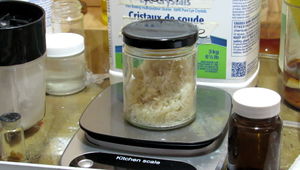Acetamide
 Freshly prepared acetamide in a jar
| |
| Names | |
|---|---|
| IUPAC name
Acetamide
| |
| Systematic IUPAC name
Ethanamide | |
| Properties | |
| C2H5NO | |
| Molar mass | 59.068 g/mol |
| Appearance | Colorless solid |
| Odor | Odorless (pure) "Mouse"-like (impure) |
| Density | 1.159 g/cm3 (20 °C) |
| Melting point | 81.16 °C (178.09 °F; 354.31 K) |
| Boiling point | 221.2 °C (430.2 °F; 494.3 K) (decomposes) |
| 200 g/100 ml | |
| Solubility | Soluble in benzene, chloroform, ethanol, glycerol, isopropanol, methanol, pyridine Slightly soluble in diethyl ether, toluene |
| Solubility in ethanol | 50 g/100 ml |
| Solubility in pyridine | 16.6 g/100 ml |
| Vapor pressure | 0.0182 mmHg at 25 °C |
| Hazards | |
| Safety data sheet | Sigma-Aldrich |
| Flash point | 126 °C (259 °F; 399 K) |
| Lethal dose or concentration (LD, LC): | |
| LD50 (Median dose)
|
7,000 mg/kg (rat, oral) |
| Related compounds | |
| Related compounds
|
Formamide |
| Except where otherwise noted, data are given for materials in their standard state (at 25 °C [77 °F], 100 kPa). | |
| Infobox references | |
Acetamide or ethanamide is an organic compound with the chemical formula CH3CONH2. It is the simplest amide derived from acetic acid.
Contents
[hide]Properties
Chemical
Dehydration of acetamide in the presence of catalyst yields acetonitrile.
Physical
Acetamide is a colorless solid, very soluble in water.
Availability
It is sold by chemical suppliers.
Preparation
Acetamide can be produced in the laboratory by dehydrating ammonium acetate.
A simpler route involves refluxing urea with glacial acetic acid.[1]
Ammonolysis of ethyl acetate is also another route.
Alternatively acetamide can be obtained in excellent yield via ammonolysis of acetylacetone under conditions commonly used in reductive amination.
Projects
- Make acetonitrile
Handling
Safety
Acetamide doesn't appear to be very toxic.
Storage
Acetamide should be kept in closed glass or PE bottles.
Disposal
Can be neutralized with a strong oxidizing mixture.